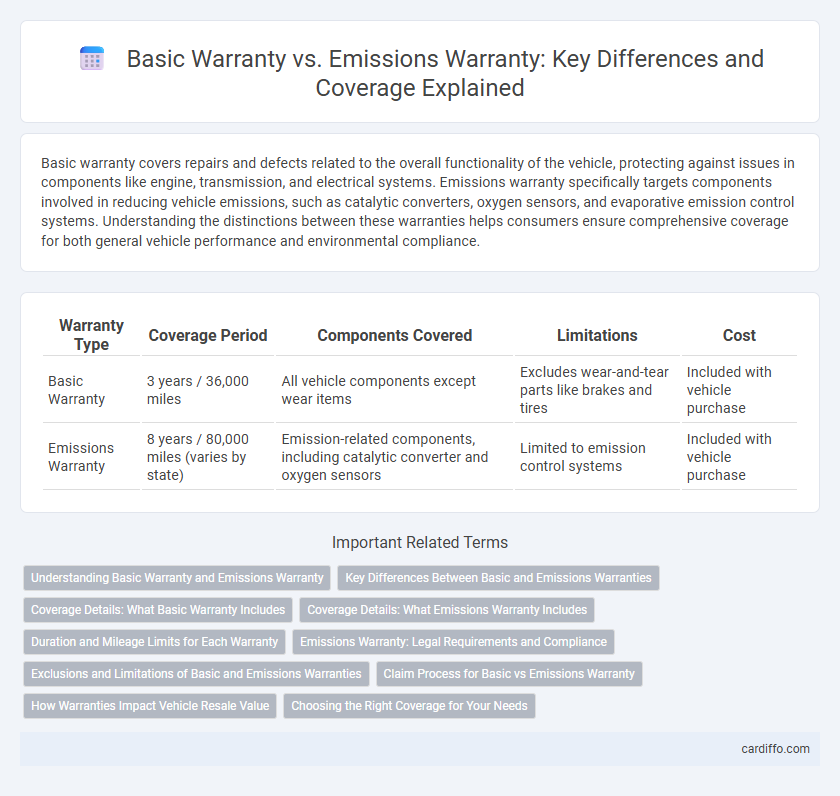Basic warranty covers repairs and defects related to the overall functionality of the vehicle, protecting against issues in components like engine, transmission, and electrical systems. Emissions warranty specifically targets components involved in reducing vehicle emissions, such as catalytic converters, oxygen sensors, and evaporative emission control systems. Understanding the distinctions between these warranties helps consumers ensure comprehensive coverage for both general vehicle performance and environmental compliance.
Table of Comparison
| Warranty Type | Coverage Period | Components Covered | Limitations | Cost |
|---|---|---|---|---|
| Basic Warranty | 3 years / 36,000 miles | All vehicle components except wear items | Excludes wear-and-tear parts like brakes and tires | Included with vehicle purchase |
| Emissions Warranty | 8 years / 80,000 miles (varies by state) | Emission-related components, including catalytic converter and oxygen sensors | Limited to emission control systems | Included with vehicle purchase |
Understanding Basic Warranty and Emissions Warranty
Understanding basic warranty involves coverage for repair or replacement of faulty parts due to manufacturing defects, typically lasting three years or 36,000 miles. Emissions warranty specifically covers components related to vehicle emissions control systems, ensuring compliance with environmental standards and often extending up to eight years or 80,000 miles. Knowing the distinctions helps consumers recognize which repairs are covered under general protection versus environmental compliance mandates.
Key Differences Between Basic and Emissions Warranties
Basic Warranty covers general defects in materials and workmanship, typically lasting 3 years or 36,000 miles, ensuring repairs for a wide range of vehicle components. Emissions Warranty specifically targets components related to a vehicle's emissions control system, such as the catalytic converter and oxygen sensors, with federally mandated coverage lasting 2 years/24,000 miles for parts and up to 8 years/80,000 miles for major items. The key differences lie in the coverage scope, duration, and focus on emissions compliance versus overall vehicle reliability.
Coverage Details: What Basic Warranty Includes
The Basic Warranty typically covers defects in materials and workmanship for a specified period or mileage, including repairs to the engine, transmission, and electrical components. It also often includes roadside assistance and excludes routine maintenance or wear-and-tear items like brake pads and tires. In contrast, the Emissions Warranty specifically addresses components related to the vehicle's emissions system, ensuring compliance with environmental standards.
Coverage Details: What Emissions Warranty Includes
The Emissions Warranty specifically covers components such as the catalytic converter, oxygen sensors, and evaporative emission control systems that are essential for reducing harmful exhaust emissions. Unlike the Basic Warranty, which generally addresses defects in materials and workmanship for overall vehicle parts, the Emissions Warranty ensures compliance with environmental regulations by covering repairs or replacements related to the vehicle's emission control system. This warranty type often extends longer than the basic coverage period, reflecting regulatory requirements for emissions control durability.
Duration and Mileage Limits for Each Warranty
Basic Warranty coverage typically lasts 3 years or 36,000 miles, offering protection against most components and manufacturing defects. Emissions Warranty extends longer, often covering up to 8 years or 80,000 miles, focusing specifically on components related to emissions control such as catalytic converters and oxygen sensors. These distinct duration and mileage limits ensure compliance with environmental regulations while providing comprehensive consumer protection.
Emissions Warranty: Legal Requirements and Compliance
Emissions warranty ensures vehicles meet federal and state air quality standards by covering repair or replacement of components related to a vehicle's emissions control system. This warranty is legally mandated under the Clean Air Act, requiring manufacturers to guarantee performance typically for 8 years or 80,000 miles, whichever comes first. Compliance with emissions warranty regulations helps reduce environmental pollution and protects consumers from costly emissions-related repairs.
Exclusions and Limitations of Basic and Emissions Warranties
Basic Warranty excludes coverage for wear-and-tear items such as brake pads, tires, and batteries, while Emissions Warranty specifically excludes components unrelated to emissions control, like audio systems and interior trims. Limitations of the Basic Warranty often include mileage caps, typically 3 years or 36,000 miles, whereas Emissions Warranty coverage may extend up to 8 years or 80,000 miles but excludes tampering or unauthorized modifications. Both warranties generally exclude damages caused by accidents, abuse, or improper maintenance, emphasizing the importance of adhering to manufacturer guidelines for full coverage.
Claim Process for Basic vs Emissions Warranty
The claim process for Basic Warranty typically involves presenting proof of purchase and vehicle identification to the dealership for covered repairs within the warranty period, with minimal documentation required. Emissions Warranty claims often require more specific documentation, including emissions test results and compliance with maintenance schedules, to validate coverage. Both warranties necessitate timely reporting of defects, but emissions claims are subject to stricter regulatory verification to ensure environmental standards are met.
How Warranties Impact Vehicle Resale Value
Basic warranties cover repairs for defects in materials or workmanship, directly enhancing vehicle resale value by assuring buyers of low repair costs. Emissions warranties guarantee compliance with environmental standards, increasing resale appeal in regions with strict emissions regulations. Vehicles with comprehensive warranties typically command higher resale prices due to reduced potential ownership costs and increased reliability confidence.
Choosing the Right Coverage for Your Needs
Basic warranty typically covers repairs and defects for a limited time or mileage, providing essential protection against manufacturing faults, while emissions warranty specifically safeguards components related to pollution control systems, ensuring compliance with environmental regulations. Selecting the right coverage depends on your vehicle's age, mileage, and regional emissions standards, as well as your priorities in managing repair costs versus environmental compliance risks. Prioritize emissions warranty if you live in states with stringent emissions testing or own a vehicle with complex emissions technology to avoid costly repairs and fines.
Basic Warranty vs Emissions Warranty Infographic

 cardiffo.com
cardiffo.com